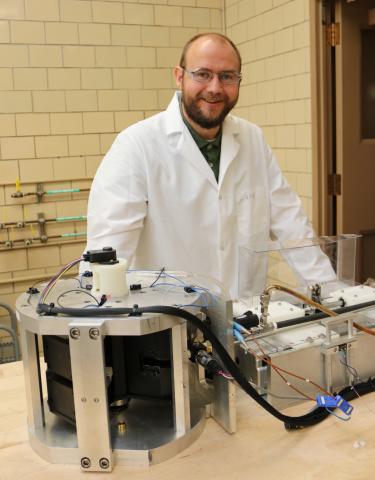The U.S. Department of Energy’s Ames Laboratory is employing a testing device that pairs materials science with engineering systems development. Called CaloriSMART (Caloric Small-scale Modular Advanced Research Test-stand), the one-of-a-kind system is being used to rapidly test new materials that might eventually be part of an entirely new kind of refrigeration technology for the 21st century and beyond.
Outdated cooling technology is one of the most pressing issues of a rapidly growing global population and the resulting environmental concerns.
“Gas compression cycle cooling is the standard used today; a very old and very mature technology,” said Lucas Griffith, a postdoctoral researcher on the project. “We’re reaching the point where we need the next big thing that could push beyond those limits, and we think magnetocaloric cooling has that ability.”
A magnetocaloric cooling system uses an active solid, relying on reversible thermal phenomena to provide cooling and heating when a magnetic field around the solid varies. For the last 20 years, materials scientists have been searching for compounds that can generate strong thermal effects when cyclically acted upon. Finding promising magnetocaloric materials is a science discovery challenge that Ames Laboratory has been a leader in from the very beginning, when project leader Vitalij Pecharsky discovered the giant magnetocaloric effect in Gadolinium-Silicon-Germanium in 1996.
But the question of how those materials will perform in an actual refrigeration system is best answered through engineering, and that’s where CaloriSMART comes in.
“We have always been at the top of the game in terms of materials discovery for this technology,” said Pecharsky, “but over time we realized that the one thing that is really hanging this advancement up from getting to the deployment stage is the disconnect between materials discovery and systems engineering. Research in these two areas must go hand-in-hand in order for it to be successful. We built CaloriSMART three years ago, and it has put Ames in a unique place in the development of this technology.”
The device is able to test materials’ cooling capabilities using small quantities in just a few hours and is flexible enough to test the same material in different forms. The device has already demonstrated results that suggest the expected performance of a larger-scale system, and helped scientists discover a new way of benchmarking the performance of magnetocaloric systems– the exergetic power quotient.
Roughly comparable to SEER, the current industry standard of explaining energy efficiency in current gas compression technology, the idea behind the exergetic power quotient was suggested by Julie Slaughter, scientist for the project, and one of the designers of CaloriSMART.
“We need to be able to see how well we’re using the most expensive component of the system, the magnetic field,” said Julie Slaughter. “Having a metric we can compare the performance of these systems against, makes it easier to determine if we’re getting the maximum performance out of the material, or whether we need to be looking at inefficiencies in the system.”
The research is further discussed in the paper, “CaloriSMART: Small-scale test-stand for rapid evaluation of active magnetic regenerator performance,” authored by Lucas Griffith, Agata Czernuszewicz, Julie Slaughter, and Vitalij Pecharsky; and published in Energy Conversion and Management.
The research is supported jointly by the Office of Energy Efficiency and Renewable Energy’s Advanced Manufacturing Office (AMO) and Building Technologies Office (BTO). AMO supports early-stage research to advance innovation in U.S. manufacturing and promotes American economic growth and energy security. BTO leads a network of partners working to develop and deploy innovative, cost-effective energy saving solutions for U.S. buildings.
Ames Laboratory is a U.S. Department of Energy Office of Science National Laboratory operated by Iowa State University. Ames Laboratory creates innovative materials, technologies and energy solutions. We use our expertise, unique capabilities and interdisciplinary collaborations to solve global problems.
Ames Laboratory is supported by the Office of Science of the U.S. Department of Energy. The Office of Science is the single largest supporter of basic research in the physical sciences in the United States, and is working to address some of the most pressing challenges of our time. For more information, please visit https://energy.gov/science.
Contacts:
Vitalij Pecharsky, Division of Materials Sciences and Engineering, 515-294-8820
Laura Millsaps, Ames Laboratory Communications, 515-294-3474
Original post https://alertarticles.info
